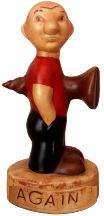 |
 The Virtual Corkscrew Museum's Weekly Newspaper |
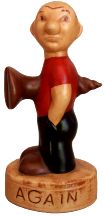 |
 |
 The Virtual Corkscrew Museum's Weekly Newspaper |
 |
|
Sunday, September 27, 2009 |
Number 577 |
Hugo Berger
The pig, the owl, and the rooster are marked GOBERG and GES GESCH (German Gesetzlich Geschützt = Legally protected).
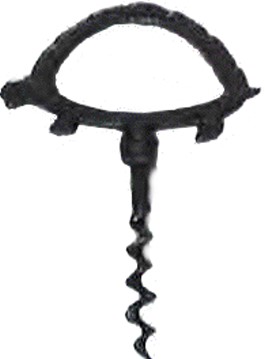
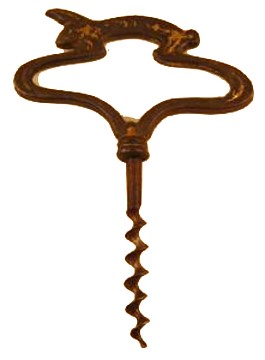
Anyone have the Goberg Turtle or Rabbit? (email better photo!)
Rabbit submitted by Jerermy AstfalckThe firm was headed by Hugo Berger (thus the name HuGO BERGer). In The Studio Year-Book of Decorative Art published in 1909, there is the small bit about Berger: "Berger, Hugo, Schmalkalden, Thuringia. Herr Berger designs and executes metal-work, mostly in hammered wrought-iron, brass and copper. Some of his designs display considerable originality, and the workmanship is always good." Here are some examples of his craftsmanship:
Most of the products from Goberg were made of iron and steel and included smoking accessories, candlesticks, boxes, etc. Pressed steel standard and interchangeable parts were used in different combinations to create new designs which were finished by hand. In the United Kingdom, Liberty & Company imported Goberg Metallwarenfrabrik products from about 1905 to 1920
In the February 18, 2007 issue we reported on the Chinese knockoff of the Goberg pig (right above).

In 1903, Hugo Berger registered a design in Germany for a tool kit having different tools that slide into a groove inside the handle.
Editor's note: Any readers have additional "Goberg" corkscrews?
Lucy Cotton
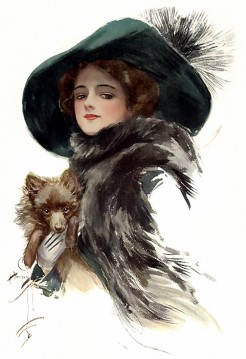
From the cover of Harrison Fisher's American Girls in Miniature
published by C. Scribner's Sons, 1912Houston born Lucy Cotton was a star of stage and screen. Her first role on stage was at the age of eighteen in the chorus of The Quaker Girl. Although her singing and dancing were not good, she became the toast of Broadway through her shining personality and perkiness.
In this brief sketch from the 1912 Volume V edition of The Texas Magazine edited by Frank Eberle and Harry Van Denmark we learn how Lucy's modelling career with the artist Harrison Fisher.
The Triumph of Miss Cotton
Miss Lucy Cotton, the young lady selected by Harrison Fisher, the artist, as the most typical type of Southern beauty is a Texas girl, formerly a resident of Houston. For some years Miss Cotton has resided in New York. It was there she met Mr. Fisher, who was the judge in a contest having its object the selection of a young woman to typify the Southern type of beauty. According to reports Miss Cotton takes her honor lightly.
Fisher's "discovery" of Lucy brought her the success she had sought in her move to New York. She was the model chosen by Fisher for one of his American Girl books. She also posed for Charles Dana Gibson (The Gibson Girls) for some of his illustrations.
This brief article appeared in the March 26, 1911 edition of the San Antonio Light and Gazette:
Houston Girl Perfect
In Miss Lucy Cotton of Houston, Tex., Harrison Fisher, the famous illustrator, has found his "perfect type" of "Southern Girl" and she has just been secured to serve as his model in a series of types he is engaged upon. Miss Cotton is tall, slender, with the grace of neck, lambent dark eyes and soft drawling voice to be found among fair women close to the borders of Mexico.
She has a dimple in her soft chin that responds to every emotion; she takes vivid and childlike interest in the development of pictures on canvas. She is waiting with even more breathless interest than the artist who is launching his Southern type to see how the type will be received by a public ever critical of, as it is insistent for, creations that are new.
In the October 2, 1911 edition of the Williamsport Gazette and Bulletin [Pennsylvania], Helen Hoyt reported:
The favorite and most recent model of Charles Dana Gibson [The Gibson Girls] is Lucy Cotton, a tall, willowy girl with great soft, brown eyes and shadowy hair."
Lucy appeared in more than a dozen movies from 1910 to 1921 beginning with a bit part in D. W. Griffith's The Fugitive. Other movies included The Devil, The Misleading Lady, and Life Without Soul. She lived the high life and married several wealthy men: Edward Russell Thomas (1924 - 1926) (death); Col. Lytton Gray Ament (1927 - 1930) (divorced); Charles Hann Jr. (1930 - 1932) (divorced); W. F. Magraw (1933 - 1941) (divorced); and Prince Vladimir Eristavi-Tchitcherine (1941 - 1944) (divorced). When she married the Russian Prince, she became known as Princess Lucy Cotton. When she married Edward Russell Thomas, she gave up the stage and screen for her new life as a socialite.
The December 31, 1944 issue of The American Weekly carried a lengthy article on the divorce case of Lucy and the Prince noting "...she wanted to lose the Prince for good but remain a Princess by means of a skillful operation." In the trial, the Prince had the attitude that she could keep the title but only "over his dead body" and to the surprise of all he stated that he wasn't really a Prince because he gave up his title when he became an American citizen and simply incorporated "Prince" into his name. Lucy, it turns out, was not a Princess after all. Lucy, however, continued to use the title Princess.
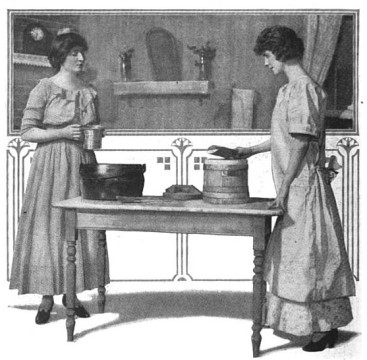
Lucy Cotton on stage with Alice Hastings in the 1917
stage comedy Turn to the Right (from Munsey's Magazine).On January 1, 1949 The Billboard magazine carried this brief notice under the section "The Final Curtain":
Magraw - Lucy Cotton, 57, former actress, December 12 in Miami Beach Fla. She made her first Broadway appearance in the musical, The Quaker Girl, followed by top roles in Up in Mabel's Room, Turn to the Right, Lightnin', and many others. She also appeared in films with George Arliss in The Green Goddess and The Devil. She was the owner of the Macfadden-Deauville Hotel, Miami. Her daughter survives.
Lucy died of an overdose of sleeping pills.
The other side of Lucy
In searching articles in newspapers from coast to coast from 1910 to 1950, we found mostly news of Lucy's years as a stage and screen star as well as stories of the high life she led subsequent to that career. But she did have another side. She was an inventor.
The only newspaper mention we could find of her inventiveness was in a posthumous article in The American Weekly in which Gene Coughlin wrote "She was busy inventing such objects as a two-handed grip for safety razors when the overpowering loneliness and need for oblivion seized her just before Christmas of 1948."
In Mrs. Astor's House, a collection of biographical sketches published in 1935, Stanley Walker quotes Lucy, "I am quite an inventor. I dream about them at night and then get up and invent things. I have to turn my thoughts away from inventions or I would be busy with them all the time. I have invented a lipstick, a beaded bag, a cigarette lighter and a cigar case."
Lucy was granted 15 utility patents and 7 design patents. Her first 13 patent applications were filed between July 1927 and September 1929 while living in New York City. The other nine were filed between May 1944 and December 1946 while living in Miami. The last patent for a Massaging Device was granted posthumously in 1950. A table of her patents can be found at the end of this article.
The biggest surprise for readers of The Weekly Screw will be her design patent for a "Bottle Opener" which shows in the drawing a corkscrew combined with the bottle opener. Was it produced? If you have one, email a photograph.

Lucy Cotton's Patents
Date format is yyyymmdd
Number Filed Issued Title Name Location 1655452 19270721 19280110 Mirror Attachment for Toilet Articles Lucy Cotton Ament New York 1690046 19270721 19281030 Receptacle Lucy Cotton Ament New York 1663966 19270722 19280327 Collapsible Commode Lucy Cotton Ament and Clara Hilfiker New York D79059 19270803 19290730 Design for a Handle for Articles Lucy Cotton Ament New York 1720460 19270804 19290709 Windshield (for lighter flame) Lucy Cotton Ament New York 1703759 19270812 19290226 Bottle Cap and Opener Lucy Cotton Ament New York 1666064 19270909 19280417 Liquid Dispensing Pump Lucy Cotton Ament New York 1694959 19270915 19281211 Atomizer (Figural) Lucy Cotton Ament New York 1725726 19280214 19290820 Bottle and Opener Lucy Cotton Ament New York 1801464 19290216 19310421 Holder for Lipsticks and the Like Lucy Cotton Thomas* New York 1865063 19290502 19320628 Container (for cigarettes and matches) Lucy Cotton Thomas* New York 1811103 19290824 19310623 Lighter Lucy Cotton Thomas* New York 1801465 19290925 19310421 Holder for Lipsticks and the Like Lucy Cotton Thomas* New York 2376036 19440526 19450515 Collapsible Commode Lucy Cotton Miami D139210 19440816 19441024 Manicure Scissors Lucy Cotton Miami D141521 19440906 19450612 Seal Stamp Lucy Cotton Miami D140136 19441107 19450123 Writing Pad Holder Lucy Cotton Miami D141954 19441107 19450807 Roller Blotter Lucy Cotton Miami D140622 19441206 19450320 Bottle Opener Lucy Cotton Miami D140654 19441230 19450327 Razor Lucy Cotton Miami 2416157 19450606 19470218 Telephone Dial Attachment Lucy Cotton Miami 2506856 19461203 19500509 Massaging Device Lucy Cotton Miami *Name change from Lucy Cotton Ament on issued patent
Here are some of Lucy's patent drawings
Bottle Cap and Opener
Bottle and Opener
Atomizer
Writing Pad Holder Massaging Device
Container (Cigarettes etc.)
Buyer Beware
Wayne Meadows has provided an interesting study on Austrian corkscrew fakes. See: http://www.hagenauerfakes.com/. Readers are advised to take a close look at Wayne's documents before buying "rare" and "unusual" Austrian figurals. Wayne notes that many of the fakes have the Austrian marks.
|
©2009 Don Bull, Editor |